Siopao asado is the Filipino equivalent of a steamed pork bun. It's filled with braised meat in a deliciously sticky, sweet, and salty sauce. The bun dough also doesn't require too much time proofing, but they are still fluffy and structured enough to keep the filling from spilling out.
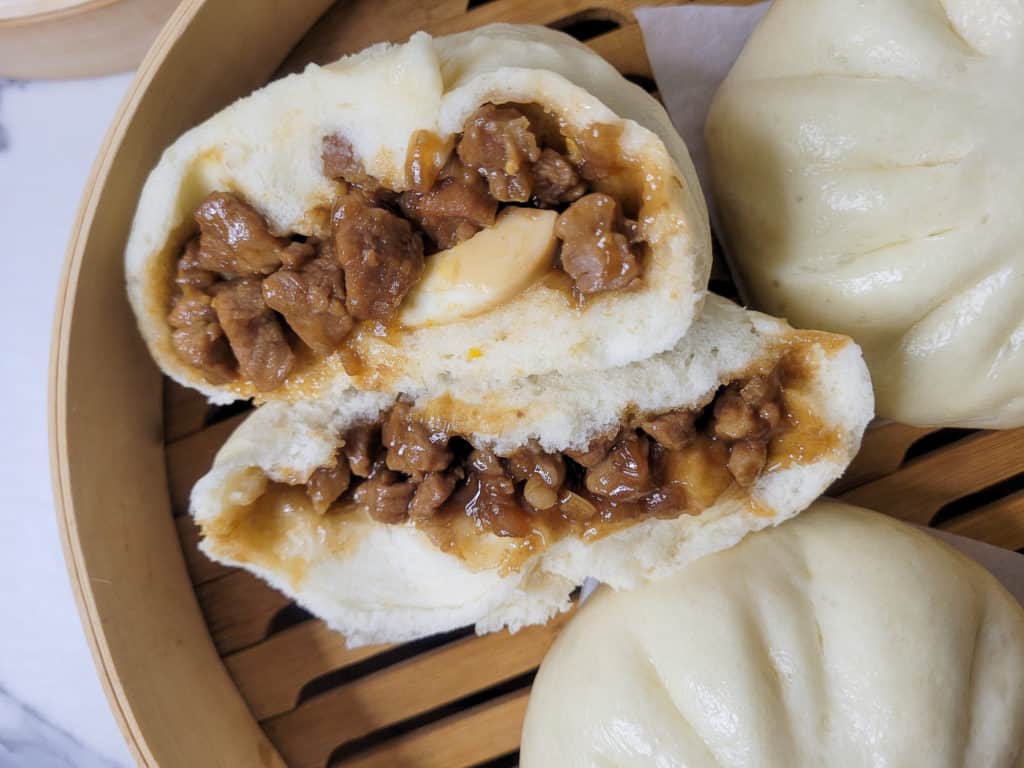
Update Disclosure: This post has been updated for one or more of the following reasons: easier reading, updated photos, clearer instructions, and just plain ol' improvements to the recipe (as noted).
My favorite type of buns are either baked (like empanadas) or steamed (filled with just about anything). However, this one tops the list!
Jump to:
History of Siopao Asado
The two names of this bun are the perfect example of the Philippines' diverse historical influences. Siopao asado means "steamed bun with braised meat". The first word, siopao, is a word that has Chinese roots, while asado comes from Spain. Siopao comes from the word baozi which means "steamed bun". There are two meanings for the word asado in Tagalog: grilled and braised meat. But asado in the Philippines is a given name to specific Filipino dishes instead of how the Spanish uses the word asado, as an adjective that means "roasted".
In this bun, asado is the braised meat dish cooked and cooled before being added to the bun dough. You can add other fillings to siopao, which is the steamed bun. Another popular siopao filling is called bola-bola, which I can best describe as a meatball in a bun.
The Easier Char Siu Bao
You like char siu baos? Well this one is easier to make and tastes just as good. Making char siu from scratch is extensive. You gotta marinate it, then roast it, baste it, and roast it, then baste it again. Let me go on the record and say, I tend to eat a lion's share of char siu baos. But I'll leave these buns to the super dim sum experts!
With siopao, you throw your filling ingredients in a deep pan and braise the meat for an hour. The buns typically need two proofing periods, but this one skips one. So even less steps!
Ingredients
These are the items you'll need from your pantry to make the buns and the filling:
- All-Purpose Flour
- Baking Powder
- Active Dry Yeast
- Granulated Sugar
- Water
- Pork Shoulder
- Garlic
- Onion
- Soy Sauce
- Dark Soy Sauce
- Oyster Sauce
- Cornstarch
- Eggs
Substitutes
- Dark Soy Sauce: Go ahead and use more of the regular soy sauce for this recipe if you don't have this special type in your kitchen.
- Pork Shoulder: A fatty cut of pork will do such as pork belly and pork neck. But any bits of lean pork with fatty pork also work. If you don't want to chop at all, you can even opt for ground pork - it also works!
- Active Dry Yeast: You can use instant dry yeast and skip the blooming step. Just add the milk, sugar, and yeast directly to the rest of the dry ingredients.
Recipe Tips
- Taste Test: Test the meat for tenderness after braising about thirty minutes. If you find that it's still too hard, add another ten minutes to your braising time. Add more time if you feel like it's not tender to your liking after forty minutes. I actually like a bit of bite to my filling, so it provides a contrast to the soft dough!
- Longer Resting Time: If you do have time, let the pork rest in the fridge for longer than an hour. The more solid it is, the easier it will be to add the filling on the dough and shape the buns.
- Prepare Parchment Paper: Before building the buns, take some parchment paper and cut them into squares so you can stick them at the bottom of each bun. You will need eight for this recipe.
- The Perfect Steaming Method: Once you are done steaming your buns, do not remove the top cover just yet! Remove the whole steamer from the hot water and place it on the counter to rest covered for about three to five minutes. This way, you lock in moisture and the buns will be their fluffiest once that crucial resting period is complete.
How to Make Siopao Asado
I don't want to oversimplify this, because it does take some effort and time.
Here's a quick preview of what you'll do:
- Brown the pork in a pan with garlic and onions.
- Add the sauces and braise for an hour.
- Thicken the braised meat. Allow it to cool.
- Make the dough by blooming the yeast in milk and sugar first.
- Then add it to the dry ingredients.
- Knead the dough and split into eight pieces.
- Flatten a piece of dough and add filling in the middle.
- Close it up to make a bun. Repeat the steps 7 or 8 seven more times.
Storing Siopao Asado
If you plan to make a batch and save the rest, let the steamed buns cool to room temperature and place them in a ziplock bag. Put the bag in the freezer. When you are ready to eat one, place a frozen bun in the steamer and steam it for about fifteen to twenty minutes.
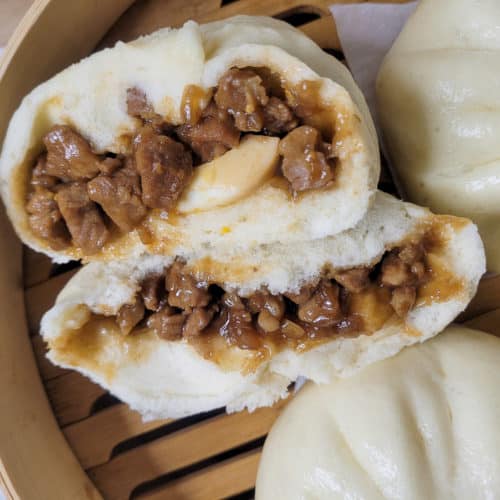
Siopao Asado (Filipino Pork Bun) Recipe
Disclosure
The equipment and ingredients sections contain affiliate links to products I love to use as well as items that I personally believe make this recipe the best version of itself.
Ingredients
Bun
- 400 grams all-purpose flour
- 4 grams baking powder
- 4 grams yeast
- 60 grams granulated sugar
- 215 grams warm water
Filling
- 500 grams (~ 1 pound) pork shoulder, diced small
- 6 cloves garlic
- ½ medium onion, diced small
- 2 tablespoon soy sauce
- 2 tablespoon oyster sauce
- 3 tablespoon granulated sugar
- 1 tbsp dark soy sauce
- 1 tbsp cornstarch
- 350 grams water
- 2 boiled eggs, quartered optional
Instructions
Make Filling
- Add the cornstarch and water in a small bowl, mix until clumps disappear, set aside. Heat a bit of oil in a pan and add the pork. Cook until browned and liquid has evaporated. Add garlic and onions, cook for two minutes with browned pork.
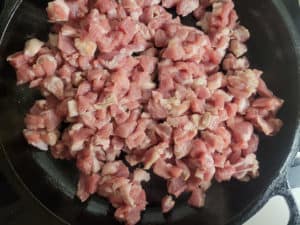
- Add soy sauce, dark soy sauce, sugar, and oyster sauce. Mix well and cook for another 2 minutes.
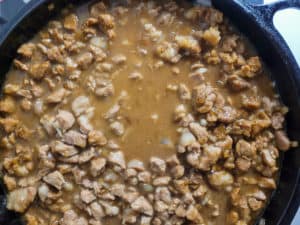
- Add cornstarch slurry and braise on low heat for 40 - 50 minutes or until the meat reaches a tenderness to your liking. Add some more water if the sauce gets too thick and you want to continue braising.
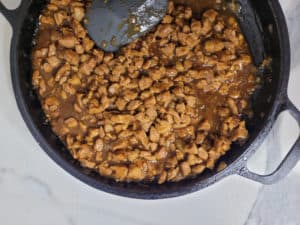
- When the meat is tender and the sauce has a thick consistency, remove from heat and add to a bowl. Set it aside and cool to room temperature. About 1 hour.
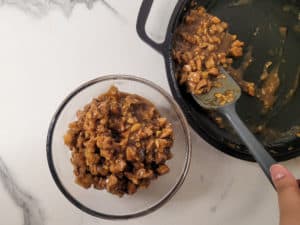
Make Bun Dough
- In a bowl add yeast, warm water and 1 tablespoon of the measured sugar, mix well and set aside to activate for 10 minutes.
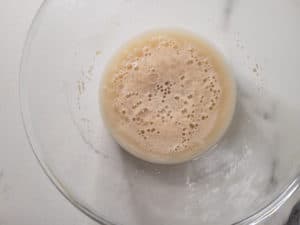
- In a large bowl, add the flour, baking powder, and the rest of the sugar then whisk the dry ingredients to mix. Add the activated yeast and mix everything until the dough comes together.
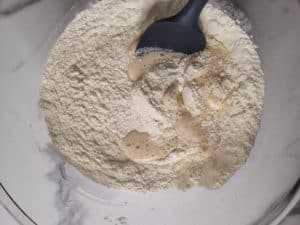
- Place the dough on a flat surface and knead for about 10 minutes or dough is smooth when rolled to a ball. Split the dough into 8 equal parts and set aside covered with cling wrap to keep them from drying.
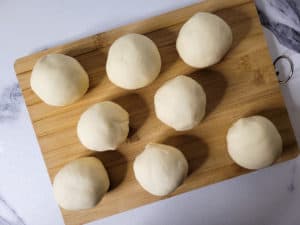
Assembly
- Take one dough ball and flatten with a rolling pin, then shape into a large circle that is thickest at the center.
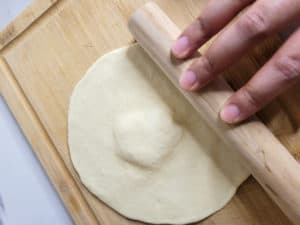
- Place some of the refrigerated filling in the center (add a slice of egg if you are using boiled eggs) and close the bun by pinching the edges together. Gently roll under your palm to reshape to a ball if necessary.
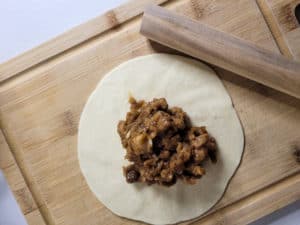
- Place a small square of parchment paper under the bun. Repeat the steps above until all dough balls are filled. Place the buns in a steamer with a space of about 1 inch (2.5 cm) between them. Cover to proof for 40 minutes.
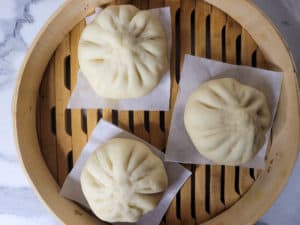
Steaming the Buns
- Fill a pot about halfway with water. Place it on the stove and bring it to a low boil. Steam the buns for about 15 minutes and then remove the steamer from the heat while it's still covered.
- Remove from the heat but do remove the lid. Keep the buns covered in the steamer and let them cool on the counter for about 3 minutes before eating.
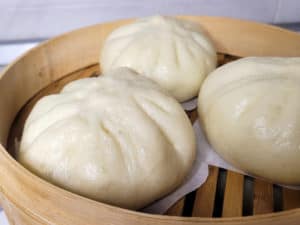
Notes
Nutrition
Have You Tried This Recipe?
Simply rate the recipe by clicking on the ⭐️s on the recipe card. Have something to say? Please leave me a comment down below telling me what you think of this recipe.
Bonus: Let me and other readers know what you did to make this recipe your own - 💫 let's inspire each other!
Also, follow me on Instagram [@seesfoodwilltravel] and send me a DM with a picture of what you made. I would love to share and celebrate YOUR creation with our budding community 💞
Check out Sees Food, Will Travel on Pinterest and Facebook for more delicious updates.




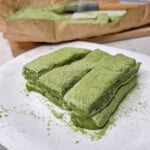

Caitlyn says
I made these last weekend for my whole family and everyone thought they were were amazing! They had a great balance of savoury and sweetness and the bun was fluffy and light. I subbed shoulder for ground pork because I'm a grad student on a budget but everything else, I followed exactly. I will say that for me (and my mother) the egg definitely was not optional and was one of my fave parts so don't skip out on it!!!
Joanne says
I'm so happy to hear you liked it! Subbing the ground pork was a smart and economical move. Thanks!